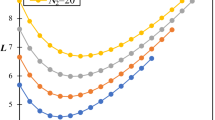Abstract
We consider a queueing system where some customers decide to simultaneously wait in two queues, rather than in a single queue, to receive their service. In practice, when there exists a number of queues rendering the same service, the customers may tend to simultaneously wait in more than one queue in order to receive the service sooner and thus scale down their waiting time. In this framework, the customers may abandon one of the queues when they are called to receive the service from the other. We treat this situation as customer reneging or abandonment. We study the customer’s waiting time under this model for the cases of independence and dependence of the waiting time random variables of the queues. In conducting this study, a Copula approach is applied to take into account the dependence structure of the waiting time random variables. We compare the numerical results of the dependence with that of the independence.
Similar content being viewed by others
References
Ancker CJ Jr, Gafarian AV (1963) Some queuing problems with balking and reneging. I. Oper Res 11(1):88–100
Baccelli F, Hébuterne G (1981) On queues with impatient customers, Performance ’81 (Amsterdam, 1981). North-Holland, Amsterdam, pp 159–179
Baccelli F, Boyer P, Hébuterne G (1984) Single-server queues with impatient customers. Adv Appl Probab 16(4):887–905
Behzad R, Salehi Rad M (2017) Simultaneous arrival of customers to two different queues and modeling dependence via copula approach. Accepted for publication by Communications in Statistics-Simulation and Computation (15 August 2017). Published online: 23 January 2018
Daley DJ (1965) General customer impatience in the queue GI/G/1. J Appl Probab 2:186–205
De Kok AG, Tijms HC (1985) A queueing system with impatient customers. J Appl Probab 22:688–696
Garnett O, Mandelbaum A, Reiman M (2002) Designing a call center with impatient customers. Manuf Serv Oper Manag 4(3):208–227
Lee C, Wang JC (2011) Waiting time probabilities in the M/G/1 + M queue. Stat Neerl 65(1):72–83
Nelsen R (2006) An introduction to copulas, 2nd edn. Springer, New-York
Stanford RE (1979) Reneging phenomena in single channel queues. Math Oper Res 4:162–178
Robert CP, Casella G (2010) Introducing Monte Carlo Methods with R. Springer, Berlin
Rosenblatt M (1952) Remarks on a multivariate transformation. Ann Math Stat 23:470–472
Author information
Authors and Affiliations
Corresponding author
Appendices
Appendix I
Proof of Proposition 2:

The first term  in the right-hand side of the above relation can be written as follows.
in the right-hand side of the above relation can be written as follows.

The last equation was concluded due to the point that T1 and T2 are assumed to be independent random variables. Thus, one can write

where \(A=\frac {\theta \cdot \omega \left (-\beta ,\sqrt {\frac {\mu }{\theta }}\right )h\left (\beta \sqrt {\frac {\mu }{\theta }}\right )}{\phi \left (\beta \sqrt {\frac {\mu }{\theta }} \right )}\) and \(B=\frac {\sqrt {N\mu \theta }}{\phi \left (\beta \sqrt {\frac {\mu }{\theta }}\right )}\omega \left (-\beta ,\sqrt {\frac {\mu }{\theta }}\right )h\left (\beta \sqrt {\frac {\mu }{\theta }}\right )\).
Likewise, the second term  in the right-hand side of the above relation can be expanded.
in the right-hand side of the above relation can be expanded.
Appendix II
Let the second term in the right-hand side of Eq. 7 be denoted by J, and let g(t2) be the integral inside this term. Then, we can write
where Eξxp(⋅) denotes an expectation to be computed under exponential distribution with parameter 𝜃′. Let the expression inside this expectation which has been multiplied by g(T2) be denoted by R(T2).
Now, g(t2) can be written as follows:
Then, by applying some manipulation, we arrive at
where \(g^{\prime }(t_{2})={\int }_{0}^{t_{2}} e^{-\frac {N\mu \theta }{2}{t_{1}^{2}}-\left (\beta \sqrt {N}\cdot \mu +\theta \right )t_{1}} dt_{1}\). By considering a uniform distribution for U, i.e. U ∼ U(0,t2), then g′(t2) can be written as follows:
where \(K(u)= t_{2} \cdot e^{-\frac {N\mu \theta }{2}u^{2}-\left (\beta \sqrt {N}\cdot \mu +\theta \right )u}\).
We then apply the following algorithm based on the importance sampling method to estimate J.
- i)
Generate n random values from Eξxp(𝜃′) to be considered as values of t2.
- ii)
For each value of t2 as obtained above, compute R(t2).
- iii)
For each value of t2 as obtained above, compute g′(t2). To this end, the following steps are taken:
- a)
Generate n random numbers from U(0,t2) to be considered as values of u.
- b)
For each value of u, compute K(u).
- c)
Calculate \(\frac {1}{n}{\sum }_{i = 1}^{n}K(u_{i})\) to be utilized as an estimate for g′(t2).
- a)
- iv)
Compute g(t2) using g′(t2) obtained above.
- v)
Take \(\widehat {E}=\frac {1}{n}{\sum }_{i = 1}^{n}g(t_{2i})\cdot R(t_{2i})\) as an estimate for Eξxp[g(T2) ⋅ R(T2)].
- vi)
Finally, take \(\frac {B\cdot w\left (-\beta ^{\prime },\sqrt {\frac {\mu ^{\prime }}{\theta ^{\prime }}}\right )h\left (\beta ^{\prime }\sqrt {\frac {\mu ^{\prime }}{\theta ^{\prime }}}\right )}{\theta ^{\prime }\phi \left (\beta ^{\prime }\sqrt {\frac {\mu ^{\prime }}{\theta ^{\prime }}}\right )}\cdot \widehat {E}\) as an estimate for J.
Rights and permissions
About this article
Cite this article
Behzad, R., Salehi Rad, M.R. & Nematollahi, N. Queues with Simultaneous Arrival of Customers and the Dependence Structure of the Waiting Times. Methodol Comput Appl Probab 21, 1045–1056 (2019). https://doi.org/10.1007/s11009-018-9647-y
Received:
Accepted:
Published:
Issue Date:
DOI: https://doi.org/10.1007/s11009-018-9647-y




